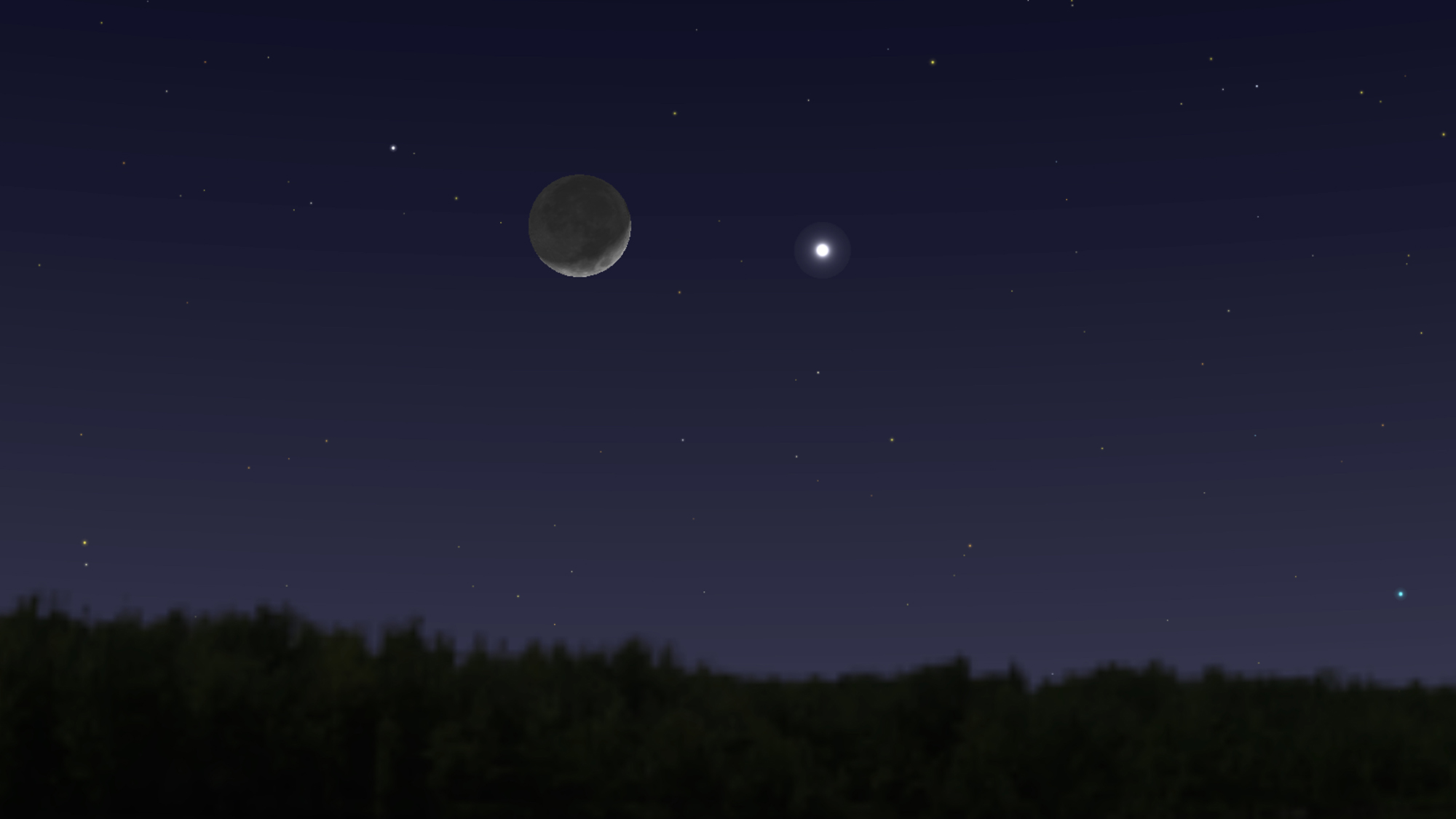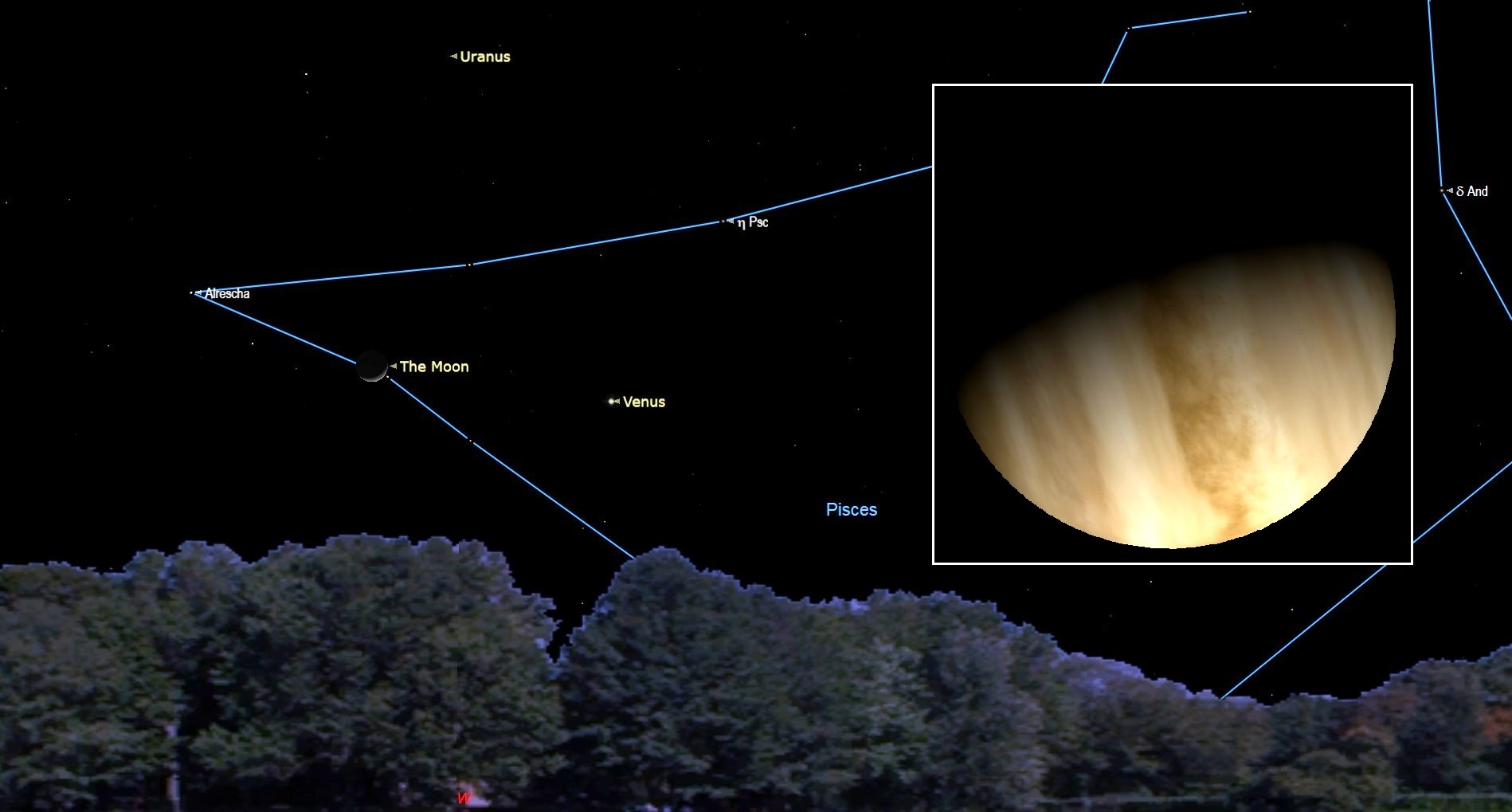How to see Venus shining with the moon tonight
Tonight (Feb. 27), as darkness is falling, be sure to look toward the west-southwest sky to spot another beautiful celestial tableau formed by a lovely crescent moon and the brilliant planet Venus.
Venus will appear to hover far to the right of the moon. The objects will be separated by about 6.5 degrees. The width of your clenched fist held at arm's length measures roughly 10 degrees, so, Venus and the moon will appear a bit more than a half fist apart.
These Venus-moon rendezvous occur on roughly a monthly schedule. If Venus were stationary and did not appear to move against the star background, a Venus-moon encounter would occur every 27 days, 7 hours and 43 minutes. This is called a "sidereal month," which is the length of time it takes the moon to circle Earth once using the background stars as a reference point. Because Venus and the moon were together on Jan. 28, we might have expected a return engagement this past Monday (Feb. 24) if we tried to apply the "sidereal month rule" to this schedule.
Related: The brightest planets in February's night sky: how to see them (and when)
Venus on the move
Of course, that rule didn't work because Venus is not stationary; it's moving in its own orbit around the sun. From our Earthly viewpoint, Venus has appeared to shift considerably to the east against the star background. Back on Jan. 28, Venus was in the constellation Aquarius, the water carrier. But today, it will appear to have shifted more than 35 degrees to the east, where it currently resides in the constellation Pisces, the fishes.
So, the moon had to travel that much more across the sky to catch up to Venus. Because the moon appears to move across the sky at roughly 13 degrees per day, it needs three more days to catch up to Venus. That takes us to tonight, when once again we will be treated to an eye-catching sight in our western twilight sky between the two brightest objects in the night sky.
And so is our Earth
Incidentally, another factor that must be considered is Earth's movement around the sun. If, in fact, you looked for the crescent moon this past Sunday night (Feb. 23), you wouldn't have been able to see it because it was at new phase and hence too near to the sun to be seen. That's because, during the 26 days that had elapsed since Jan. 28, Earth's movement around the sun would have caused the sun's position in the sky to shift to the east as well — in this case, right into the very same region that Venus and the moon occupied on Jan. 27.
Breaking space news, the latest updates on rocket launches, skywatching events and more!
By tonight, however, the moon will be well clear of the sun and readily visible in the west-southwest sky with Venus. Now gleaming at magnitude -4.3, Venus has been ascending dramatically higher in February and now is setting more than 3.5 hours after the sun. No other star (other than the sun) or planet can come close to matching Venus in brilliance. During World War II, aircraft spotters sometimes mistook Venus for an enemy airplane. There were even cases where Venus drew anti-aircraft fire.
And lastly, if clouds obscure your view of Venus and the moon tonight, don't fret — future opportunities to see them together again will come on March 28 and April 26.
- What is a 'morning star,' and what is an 'evening star'?
- Best night-sky events of February 2020 (stargazing maps)
- There may be active volcanoes on Venus: new evidence
Joe Rao serves as an instructor and guest lecturer at New York's Hayden Planetarium. He writes about astronomy for Natural History magazine, the Farmers' Almanac and other publications. Follow us on Twitter @Spacedotcom and on Facebook.
OFFER: Save at least 56% with our latest magazine deal!
All About Space magazine takes you on an awe-inspiring journey through our solar system and beyond, from the amazing technology and spacecraft that enables humanity to venture into orbit, to the complexities of space science.

Joe Rao is Space.com's skywatching columnist, as well as a veteran meteorologist and eclipse chaser who also serves as an instructor and guest lecturer at New York's Hayden Planetarium. He writes about astronomy for Natural History magazine, Sky & Telescope and other publications. Joe is an 8-time Emmy-nominated meteorologist who served the Putnam Valley region of New York for over 21 years. You can find him on Twitter and YouTube tracking lunar and solar eclipses, meteor showers and more. To find out Joe's latest project, visit him on Twitter.



